Your organization has decided to embark on the journey of pursuing accreditation! This commitment can invoke many sentiments—happiness, anticipation, fear, anxiety, and maybe even a splash of frustration. These are all normal feelings. The accreditation process is a major project with a myriad of components. One way to be successful in your accreditation work is to use a project management approach, as it is critical to divide the required work into smaller, manageable steps. Here is a handy, step-by-step guide you can use to conceptualize the tasks that are on the horizon.
Work styles & organizational culture
COA has an organization-wide accreditation model. This means that not only are programs being reviewed, but also the administrative divisions as well. Getting many colleagues involved in the accreditation process will help the organization manage the workload and focus on developing, updating, or sustaining practices that are ultimately in the best interest of the consumers served.
People have different personalities, which includes varied preferences and approaches to their work responsibilities. There are those who are process-oriented people that do a really great job poking holes in plans and asking questions that may not have been considered. Then there are staff who can reflect and acknowledge the progress that has been made within the organization through that point in time. Knowing some of these characteristics and preferences will be helpful in thinking about who should handle different aspects of the work.
How and why the organization is choosing to pursue accreditation is essential to framing the work that lies ahead. Even if the organization is mandated to achieve accreditation, what the organization hopes to accomplish through this process is valuable for all to hear. Ask yourself: What is the message we will convey to our board, advisory group, staff, consumers, and other relevant stakeholders about what accreditation means for the organization and its future? People want something they can believe in, something that resonates with them, so taking time to reflect and think about the “why” behind this journey is an opportunity to capitalize on building momentum.
Accreditation workload – forming the structure
COA accreditation includes all aspects of the organization’s administration and service delivery operations. There are three types of standards: administration and management, service delivery administration, and service. Most organizations will have at least ten standard sections to review based on the three categories. It is essential to have multiple staff managing different standard sections, because no one staff member will have all the answers (and that is a good thing)!
A question we often hear from organizations is “How will we manage the accreditation work?” You must consider whether your organizational structure serves as a sufficient framework to review the standards. This means that those individuals responsible for particular divisions would delegate tasks to staff within their department. For example, the director of human resources would review the human resources management standard section and assign tasks as needed to his/her staff. Similarly, program directors would follow the same process to review service standard areas.
Another option for managing the work includes the creation of functional work groups, which includes assembling teams with individuals from different departments and/or programs to review one or more standard sections. For example, an administrative work group can be formed to review multiple standard areas including risk management, administrative service environment, ethical practice, etc. This type of work group would include an interdisciplinary team of quality improvement, program, information technology, and other staff as needed.
Decision-making authority and flow of communication
Once a decision is made on whether to use the structural work groups, functional work groups, or a hybrid of the two, the organization must consider the decision-making authority. As teams begin to work on reviewing the standards against current practices, you may find that policies, procedures, and protocols may need to be developed or modified. The organization must be clear on who has the authority to implement new procedures and practices.
Typically, if hierarchical work groups are used, the head of the department or program would be responsible for managing the approval process. Larger organizations may have a chief operations officer or director, and that person may be responsible for final approval. In smaller organizations, decision-making authority may be the sole responsibility of the executive director. In functional work groups, the decision-making authority may be less transparent, so the organization should establish the process for preliminary and final approval of procedures and new protocols. This will be particularly important once staff begin doing the actual work that is part of the Self-Study and Site Visit phases of the accreditation process.
Regardless of the structure chosen to manage the work, the individual responsible for overseeing the accreditation process needs to ensure that work groups and teams routinely provide information and updates to them. Sharing information and progress with the leadership team is a must, especially if the accreditation lead is not a part of said team.
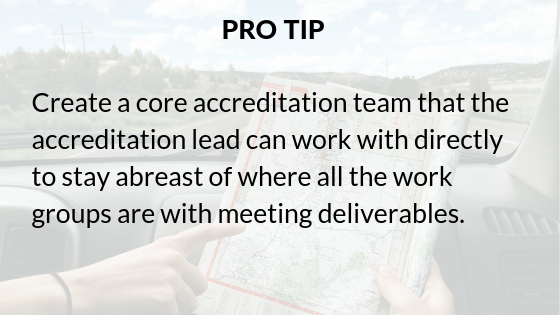
Responsibilities associated with stages of accreditation process
There are six stages in the accreditation process, each with different responsibilities. Below are some salient tasks for which the organization is responsible.
Application & agreement
The application and agreement phase of the process is an opportunity for the organization to assess the cost of accreditation and explore the service standard sections that may be relevant to the programs provided. Once the organization has decided to pursue COA accreditation, the accreditation agreement is signed and the work begins.
Intake
Think of the intake stage as COA’s opportunity to acquire information from the organization on all your programs and locations in which they operate. When highlighting the scope of services at each program, be concise. COA uses this information to determine the appropriate service standard for each program. Do not spend many months in this stage of the process – it will prolong the assignment of service standards. The organization’s Site Visit will not be scheduled until all program documentation has been submitted to COA.
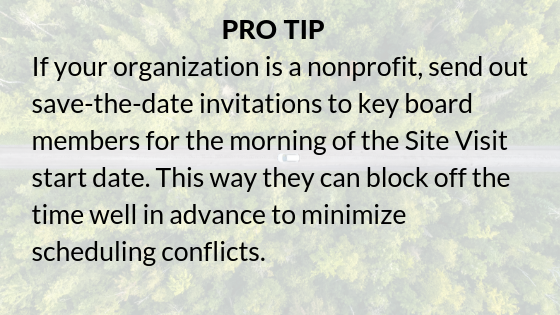
Self-Study
When the organization enters the self-study stage of the accreditation process, all standard sections have been assigned and the due dates for the Preliminary Self-Study and Self-Study have been scheduled, along with the start date for the Site Visit.
During this phase of the accreditation process, the organization should implement the structure for managing the standards review. Work groups should conduct an assessment of its current practices, policies and procedures against the COA standards. A self-assessment helps the organization to know where it needs to prioritize its time and resources.
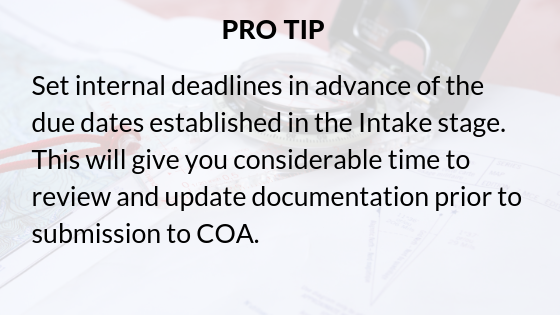
Site Visit
Once the Self-Study has been submitted, the accreditation work groups should begin compiling documentation to have available during the Site Visit. Reserve a meeting room for the Peer Review team to use while they are onsite for the duration of the Site Visit. All documentation should be clearly labelled by standard section, including the relevant core concept standard. The information the Peer Review team will evaluate can be available in paper or electronic format.
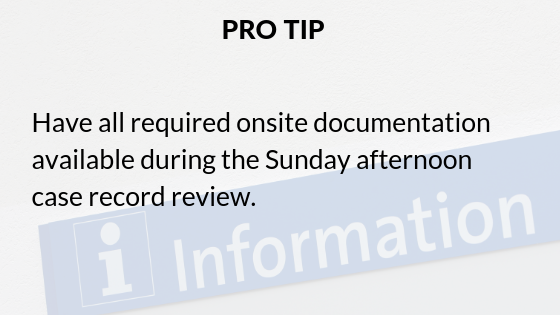
Building and sustaining momentum
If you are following the steps as listed, by now the “why” behind accreditation has already been established. An inventory of the strengths of staff has been conducted, and the process for managing the accreditation work is in place. Now the organization needs to formally roll out this significant initiative and keep staff engaged throughout the entire process.
Set a kick-off date
A kick-off event, such as an all-staff meeting, is a great way to launch the accreditation work. Use this time as an opportunity for the executive director to explain to staff why the organization is pursuing accreditation and why it is valuable. It is an opportunity to inform staff that pursuing accreditation can provide professional development and team building.

Themes and activities
Knowing the “why” behind the organization’s pursuit of accreditation may not be enough for some. For those who are charged with managing the accreditation process, consider ways to make different aspects of the work fun and exciting. Television shows, sports, movies, are all options that may be suitable to connect accreditation work groups. Visual display boards serve as a reminder and can foster healthy competition within the organization.
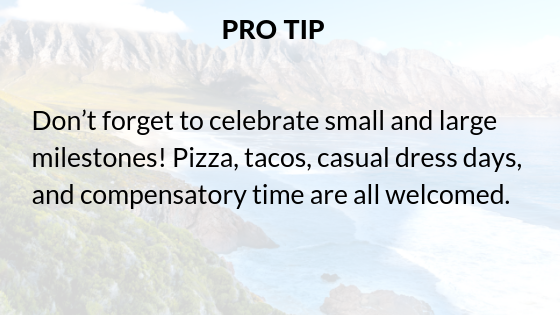
Final thoughts
The accreditation process can be overwhelming —there are many aspects that need to be managed. Hopefully, your creative juices are flowing with ways to make this organization-wide initiative manageable and fun. Remember, to get others involved, align the work with the strengths of staff and challenge the organization to always strive to be better.
Been through the accreditation process before? Share your thoughts on some things you wish you had known before you started the accreditation process. Recently completed the accreditation process? Let us know some of your pro tips that helped your organization through!
Community demographics are continuing to evolve nationwide, making the need for culturally competent organizations more prevalent than ever. In this article, we will discuss what this means for you as a provider of social services, and how your organization can progress in this realm by exploring the what, why and how of cultural competence.
The what
First, let’s define cultural competence. It can loosely be defined as the ability to respect, engage, and understand individuals who have different cultural or belief systems, where the elements of culture include, but are not limited to: age, ethnicity, gender identity, gender expression, geographic location, language, political status, race, sexual orientation, socioeconomic status, tribal affiliation, and religion.
The why
The term competency in regards to culturally responsive practice has been debated. Can one ever truly be culturally competent? There might not be a consensus, but as a provider of social services promoting cultural competence will enable you to better meet the needs of the individuals, children, and families you serve. Understanding your community and those you serve facilitates stronger partnerships, resulting in higher quality programs and service delivery. Research shows that organizational culture impacts its effectiveness. An organization that commits to cultural competence is not only better equipped to successfully address community service gaps and needs, but also creates an internal culture that fosters responsive and respectful interactions.
Here are just a few of the many benefits, it:
- fosters stakeholder engagement and empowerment
- ensures strategic initiatives, goals, and objectives to be culturally appropriate and inclusive of community needs
- supports the recruitment and retention of a diverse and inclusive governing body and workforce
- creates a safe and supportive environment that accepts and respects diversity
The how
Seek stakeholder feedback
Connect with your community! The best way to do that is to offer formal and informal ways for clients and community members to provide feedback about the work that you do. That’s why COA highlights the importance of stakeholder involvement in performance and quality improvement systems in its standards. As an organization, you get a sense of what’s working and what’s missing the mark. You can then tailor your services and outreach efforts to ensure that they are culturally appropriate. Most importantly, when you incorporate client and community feedback it makes those you serve active in organizational decision-making processes and promotes engagement and empowerment.
Conduct a community needs assessment
Conducting a community needs assessment is an effective way to identify strengths and resources in your community. It also highlights current gaps and service needs. Collaborating with community partners can enhance this assessment. You can also review other external needs assessments conducted by organizations with a community-wide focus. KIDS COUNT data center, a project of the Annie E. Casey Foundation, allows you to access local, state, and national level data and statistics on demographics and child and family well-being that can be incorporated into your assessment process.
Incorporate community demographics into your strategic planning process
Strategic initiatives should be responsive to changing community demographics and service needs. COA recommends that organization leadership review a demographic profile of their defined service population at least once every long-term planning cycle. However, it’s not enough to collect and review demographic data; it must inform an organization’s planning and operations. Promote cultural competence by establishing goals and objectives that are culturally appropriate for those you serve. Want to go a step further? Incorporate a cultural competency plan into your strategic planning process.
Foster a culturally responsive workforce
Promote cultural competence by having a diverse and inclusive workforce. A first step is ensuring that your human resources practices are culturally appropriate. Organizations should strategically recruit and employ personnel that reflect cultural characteristics of the service population. Is this a challenge for your organization? Create a plan that establishes goals for recruiting and employing individuals that represent your service population and community.
Another way you can commit to promoting cultural competence is by providing relevant education and training opportunities to personnel at all levels. Opportunities should not only focus on work with clients, but also address the internal workplace and interactions amongst other staff. Education and training should be tailored to the needs of your organization, but may include: language classes, interpreter training, mentoring programs, and diversity workshops. You can also conduct workforce assessments to inform ongoing personnel development opportunities to ensure that all staff is trained on culturally responsive policies, procedures, and practices. Once personnel have the necessary education and training, it’s time to integrate culturally responsive practices into everyday work with clients. As a provider, your goal should be to provide respectful, effective, and equitable care. This stems from adopting a service philosophy that is culturally responsive to those you serve, and culturally appropriate program-level policies and procedures.
Arguably one of the most important things that you can do as an organization is create safe and supportive environment where personnel can explore and gain an understanding of different cultures. You can do so by creating a cultural advisory committee to address workforce diversity issues or holding “cultural conversations” where staff can discuss diversity issues and learn from one another. Offering these types of forums reinforces a culture that is accepting and responsive to diversity.
Establish and maintain a diverse and inclusive board
One major responsibility of a nonprofit board is establishing and adopting organizational policy. Policies and procedures that support culturally responsive practice provide the framework for being a culturally competent organization. That is why having a board that reflects the demographics of the community it serves is so crucial. It’s no secret that board recruitment can be a challenge. If your organization is struggling to establish a board that is diverse and inclusive, establish a stakeholder advisory group that is representative of the community you serve and create a board recruitment plan that outlines strategies for getting everyone at the table. Need a little guidance? BoardSource is an excellent resource on board diversity, equity, and inclusion.
Are you feeling overwhelmed?
Don’t be. One of the most important things for organizations to keep in mind is that cultural competence is an evolving, active process; it’s not something that is attainable overnight. In fact, some researchers say there is a cultural competency continuum. The takeaway here is that every step you make towards becoming a culturally competent organization is a step in the right direction.
Want to learn more?
There are plenty of resources floating around the Internet that address cultural competence. Here are a few that you may find helpful:
The National CLAS Standards are a set of guidelines that aim to reduce health care disparities and advance health equity. COA developed a crosswalk to demonstrate how COA standards align with the National CLAS Standards and support the provision of culturally and linguistically responsive services.
National Center for Cultural Competency (NCCC)
The National Center for Cultural Competency (NCCC) aims to promote health and mental health equity through the promotion of culturally and linguistically competent service delivery systems and offers a variety of resources and publications geared towards the promotion of cultural competence.
Standards and Indicators for Cultural Competence in Social Work Practice
Are you a social worker? The National Association of Social Workers (NASW) developed standards and indicators for cultural competence in social work practice.
Substance Abuse and Mental Health Services Administration (SAMHSA)
The Substance Abuse and Mental Health Services Administration (SAMHSA) provides a host of information around cultural competency in the field of behavioral health. Check out this manual which focuses on helping providers and administrators understand the role of culture in the delivery of mental health and substance use services.
Okay, your turn!
What are some challenges your organization faced in this area and how have you attempted to overcome them? Can you share any tips, tools or resources that lead to your success? Please leave a comment below and help others learn from your experiences.
When beginning the accreditation process – specifically the completion of the Self-Study – one of the most intimidating challenges can be trying to figure out how to organize the work and delegate it to your staff. You don’t need a certificate in project management to accomplish this task (although having one won’t hurt!). What you do need is prep time, focus, and a solid understanding of what’s expected.
This post will discuss how to form effective workgroups that can assist your organization with completing the necessary work in order to achieve accreditation – and hopefully improve your organization’s operations as well. Now let’s get started.
When talking with organizations in COA’s network, we see a variety of types of workgroups. Some small organizations do not form new workgroups; they simply utilize a currently existing structure to fill the role. On the other hand, large organizations may develop multiple workgroups that focus on different aspects of the Self-Study. Only the organization can determine what the best model is going to be, but we can certainly explore some basic characteristics.
According to Kozlowski, S. W. J., & Bell, B. S. (2013), workgroups have the following qualities:
- They consist of two or more people
- Their participants are part of the same organization
- They have a common goal
- Their tasks are completed together and individually
- They involve social interaction
- They retain boundaries established by the organization
- They are part of the culture of the organization
One is the loneliest number
If your workgroup only consists of you thenyou should probably revisit your plan to achieve accreditation. Even for small organizations, all levels of staff should be involved in some way. There are multiple benefits to involving many people. First off, staff will have a better understanding of the importance of accreditation if they are embedded in the process. If the process is presented to them in a positive way then they can take ownership. A common question is “how can you present accreditation to staff in a positive way?” While it’s difficult to imagine how anyone can view accreditation in a negative light, talk with your staff – particularly those that you want to engage in workgroups – and bring the focus to achieving client outcomes. The purpose of accreditation is to improve outcomes for those that receive your services. Every action that takes place in accreditation should be tied to the end user: the consumer.
Another way that staff can buy-in to participating in a workgroup is to view it as a professional development opportunity. In fact, you would be remiss if you didn’t. Think about your shining case managers, clinicians, administrative assistants, residential managers, and foster care workers who have impeccable paperwork, organized with to-do lists, and always volunteer for new projects. Working on COA-related activities can improve their administrative and leadership skills, expand their knowledge of social service management, and program development.
“Every action that takes place in accreditation should be tied to the end user: the consumer.”
A chance for collaboration!
Another commonality in workgroups is that they are all part of the same organization. Note that it’s within the organization, but not necessarily within the same department, division, or satellite office. Workgroups foster cross-departmental collaboration. For example, let’s say that you are going to create a workgroup that focuses solely on drafting and reviewing procedures for the organization. For medium-large organizations, having this type of committee helps ensure that there is consistency across the organization, standards are still being met, and duplications are avoided. Including staff from different departments and different levels can provide different perspectives. Perhaps a member of management reviews a procedure and thinks “wow, this is great and will really help improve the reliability of our data.” Then a member of the direct service staff, who is also part of this committee, reviews the same procedure. She may have a comment such as “the intent of this procedure is spot-on, but the ability to put this in practice is unrealistic.” What’s better than a well written procedure? – A procedure that is actually practical. Having a diverse group of individuals within your organization as part of the accreditation workgroup is essential to change that is effective.
Find common ground
Common goals are an essential characteristic of workgroups. Having common goals relates to proper planning. If you establishing one committee or 3 committees to complete the work, there needs to be a goal that is achievable. You may think, “The goal is to get accredited.” Good point, that is the goal, but that’s the goal of the entire organization; not of the workgroup. The workgroup’s goal may be to establish a working PQI system, assess current practices to COA standards, or assemble the Self-Study. The goal of each workgroup will clearly delineate its role in completing the larger mission: achieving accreditation – and as we discussed earlier - to improve outcomes for consumers.
To further break down the goal, we need to identify specific tasks that support the actual completion of the workgroup’s goal. Planning, again, comes into play. Recognizing that planning is not everyone’s strong suit, there are some resources out there to assist. While COA doesn’t endorse any specific resource, we do find these helpful. Meister Task is an efficient task management application that can be used to organize individual tasks as well as collaborative tasks. Consistent with our definition of workgroups, there are both individual tasks and tasks that people must work on together. This web application can help support and provide structure to both. Another great application is Wunderlist. It provides some of the same functionality with a different style. If you are not quite ready for that level of organization and need some foundational support, try reading Getting Things Done: The Art of Stress-Free Productivity by David Allen. It’s an easy read that will help you organize your life, as well as your accreditation work. Remember, if you do utilize any of these resources, it’s recommended to take a full day to sit back and focus on implementing these systems for your work.
Assigning the work
However you handle the workload, a workgroup has tasks that are completed individually and some that are completed by more than one person or a subgroup of the committee. When tasks of the workgroup are being assigned to its members you will want to consider the strengths and weaknesses of each member. Initially, it may be your gut reaction to assign tasks that are good matches to individuals’ strengths; however, also consider matching someone’s weakness to a task to help them further develop. Perhaps pairing that person with someone who does have more experience can be a great learning opportunity. Make the most out of your accreditation experience and use it to support a positive learning environment. Maybe you can even develop mentorships within your staff, with the accreditation work as the central theme.
Involve social interaction, have you ever tried to hold a committee without social interaction? Typically that’s an email with directives to everyone involved with no discussion. Sometimes effective; most of the time not. At the beginning of the process of forming your workgroups, you will be concurrently developing the buy-in of the workgroup members. Meeting in-person, with sugary treats, that typically helps (personal favorite: Insomnia Cookies). If you can’t have fresh cookies delivered, consider holding the meeting outside of your organization, at least for the first time. Use this common goal, develop strong collegial bonds that last past COA Accreditation. And finally, manage your meeting efficiently. Here are some tips from Mindtools.com.
Introducing accreditation to your culture
Maintaining boundaries that are consistent within the organization may be a little bit more challenging for an accreditation workgroup. The group may be perceived by others in the organization as closed-off or working on something has nothing to do with the rest of the staff. One remedy for this perception is to provide communication about the status of the workgroup throughout the process to the rest of the organization. The workgroup is not charged with setting completely new and rigid policy, determining who at the organization is underperforming, or planning a coup d’état. Transparency is key, solicit feedback from staff who may not be directly involved. Always ask for volunteers, although don’t expect a waitlist. The accreditation workgroup is not a clique; it is a model for how people work as a team to achieve a seemingly insurmountable task.
Lastly, it is important to maintain key components of the organization’s culture. You can expect shifts, bumps and slides during the process, but the core of your organization will grow stronger. Your culture is the cornerstone of stability for your staff, who spend 40 hours of their lives there each week. It is a safe place for consumers whose lives you change. It is part of the connective tissue that holds your community together. Change may be inevitable but the culture of your organization is the reason for your continued success.
Share your tips!
What tips do you have for developing a strong workgroup or sustaining it once it is in place? Please leave a comment below and help others learn from your experiences.

